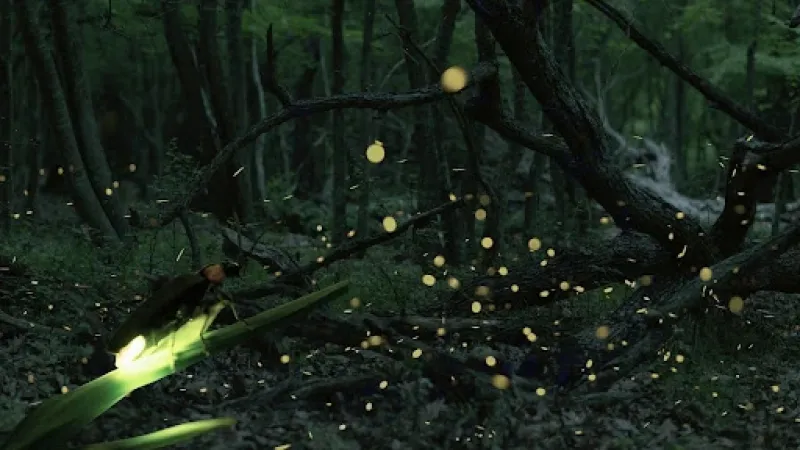
Fireflies have captivated humans for centuries with their mesmerising rhythmic dance of tiny lights. Their ability to produce cold light or light generated with almost no heat is a marvel of natural chemistry. Fireflies, also called lightning bugs or glowworms, are soft beetles belonging to the family Elateroidea. The characteristic flashing light, which is used to attract mates, warn predators, and as bait, is produced through the chemical process of bioluminescence, the emission of light by living organisms.
While humanity has been observing and studying the firefly's light for decades, a new study from Gauhati University, Assam, has raised questions about a long-standing assumption regarding the light of the firefly. The researchers discovered that the Indian firefly species Asymmetricata circumdata show variations in the colour of light emitted, contrary to what was believed.
The firefly's glow begins with a molecule called luciferin, which serves as the fuel for the light. An enzyme called luciferase acts as a catalyst, speeding up the reaction. Along with ATP (the energy currency of cells), magnesium ions, and molecular oxygen, luciferin is converted into an unstable intermediate compound. This compound then breaks down to form an electronically excited molecule called oxyluciferin. When this excited oxyluciferin returns to its normal, unexcited state, it releases the excess energy as visible light, which we see as the firefly's characteristic glow. The specific colour of this light is determined by the exact structure of the oxyluciferin and its immediate surroundings.
For decades, studies on firefly bioluminescence generally assumed that the specific colour, or wavelength peak, of light emitted by a particular firefly species was fixed. However, observations of Asymmetricata circumdata revealed that the wavelength peaks of light emitted by individual fireflies of this species are not always the same. Instead, they found a noticeable variation of 9 nanometers (nm) in the peak positions. The researchers' finding of varying peak positions within Asymmetricata circumdata suggests that these structures or microenvironments might not be as uniform across individuals as previously thought. It suggests there might be subtle changes in the structure of the enzyme luciferase, or in the chemical environment surrounding it within each firefly.
Did you know, different firefly species can emit light in various colours, ranging from green to yellow and even reddish-orange, depending on the specific chemical reactions happening inside them. The colour can also change slightly with temperature. |
To uncover this, the researchers studied 70 male specimens of Asymmetricata circumdata over three summers. They captured these fireflies from the Gauhati University campus, ensuring they were healthy and flashing naturally. Then, they recorded the steady-state emission spectra of each firefly by splitting the light into its constituent colours, similar to how a prism does. This allowed them to measure the exact colours and brightness of the light emitted by the fireflies as they flashed at their normal body temperature. The experimental setup involved gently fixing each firefly specimen in a sponge. Then a tiny optical fibre from a high-resolution spectrometer (a device that measures light) was brought very close to its light-emitting organ. This allowed the scientists to capture the light directly and analyse its spectral fingerprint.
Earlier investigations on other Indian firefly species, like Luciola praeusta, Diaphanes sp., and Sclerotia substriata, found no such variation in their wavelength peaks. This led to the general belief that an enzyme's structure, and thus its light emission, was constant within a species. The new work challenges this notion, highlighting that even subtle differences in the luciferase enzyme's structure or the tiny compartment where the light-producing reaction occurs could lead to different light colours. For fireflies, a 9 nm difference in light colour could affect how fireflies recognise and attract mates, feed, survive, and even the evolution of the species. However, the authors acknowledged that further molecular or biochemical validation is needed to support their hypothesis about the enzyme's structural changes. Future research could involve examining the luciferase protein at a molecular level to confirm these subtle differences.
Enzymes are biological catalysts, most often proteins, that accelerate specific chemical reactions vital for almost all life processes. Understanding how their structure influences their activity is crucial to fields such as medicine, biotechnology, and environmental science. By revealing that even slight variations in an enzyme's structure can alter its function, in this case, the colour of light produced, this research contributes to our broader knowledge of enzyme biology and biodiversity. Moreover, the study deepens our appreciation for the complexity of nature and provides a foundation for future studies into the subtle mechanisms that drive biological diversity.
This article was written with the help of generative AI and edited by an editor at Research Matters.





